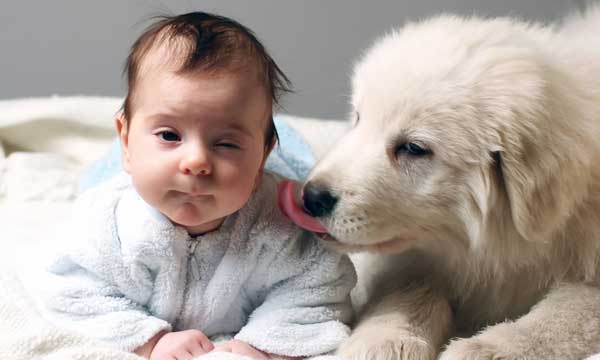Pets May Lower Babies' Infection Rates

Kids who grow up with cats or dogs tend to get fewer respiratory infections during their first year of life, according to a new study from Finland.
Researchers followed 397 children from pregnancy through their first year of life, and found that those living with dogs developed 31 percent fewer respiratory tract symptoms or infections, 44 percent fewer ear infections and received 29 percent fewer antibiotic prescriptions.
Contact with cats was also linked with fewer infections, but the effect was not as drastic as contact with dogs — for example, infants living with cats were 2 percent less likely to need antibiotics.
"We speculated that maybe the dogs somehow can bring dirt or soil inside the house, and then the immune system is strengthened, or maybe it’s something about the animals themselves," said study researcher Dr. Eija Bergroth, a pediatrician at the Kuopio University Hospital in Finland.
The link between pets and fewer infections held even when researchers took into account factors known to affect infants' infection rates, such as breast-feeding and number of siblings. Still, the researchers acknowledged that couldn't account for all such factors, and noted that they found a correlation, not a cause-and-effect relationship.
Of the children in the study, 35 percent lived in homes with dogs, and 24 percent lived in homes with cats, though the researchers also accounted for pet contact outside the home.
"According to our results, there’s no reason to be afraid of animal contact, or to avoid them," Bergroth said. While many people preparing to have a child attempt to create an extremely hygienic environment, Bergroth said, the results show this may not be the best choice, because the immune system is not challenged.
Sign up for the Live Science daily newsletter now
Get the world’s most fascinating discoveries delivered straight to your inbox.
The new findings are "incredibly novel," said Dr. Roya Samuels, a pediatrician at Cohen Children's Medical Center in New Hyde Park, N.Y., who was not involved with the study.
The research builds on the "hygiene hypothesis," a widely accepted theory that posits that children exposed to too-clean environments are more likely to develop allergies and asthma. The findings imply that the benefits of living in an environment that is more challenging to the immune system extend to lower rates of infectious diseases as well, Samuels said, which had not been previously shown.
"We associate exposure to dog and cat dander with lower allergy and asthma rates. But this paper is saying that, for reasons unknown, there is a protective mechanism at work lowering rates of infectious diseases," Samuels said.
However, exactly how this protection might work isn't clear, she said. While the researchers speculated that dirt in the home was behind the link, Samuels said there may be more to the story. Future studies to confirm the findings should further investigate the mechanisms at work, she said.
Bergroth said she hopes the research will stop people from thinking that if "they’re having children, they should get rid of animals."
Bergroth emphasized that the children studied lived in rural or suburban areas, so the study results may not translate to urban children. But she also said that urban pets may not track in the same dirt.
Pass it on: Having a pet may bolster an infant’s immune system, leading to fewer infections.
Karen Rowan contributed reporting to this story.
This story was provided by MyHealthNewsDaily, a sister site to LiveScience. Follow MyHealthNewsDaily on Twitter @MyHealth_MHND. We're also on Facebook & Google+.









